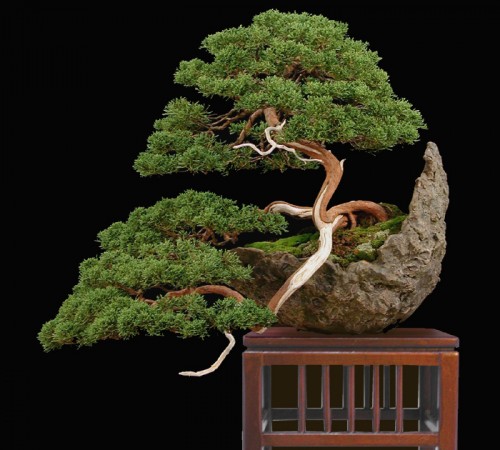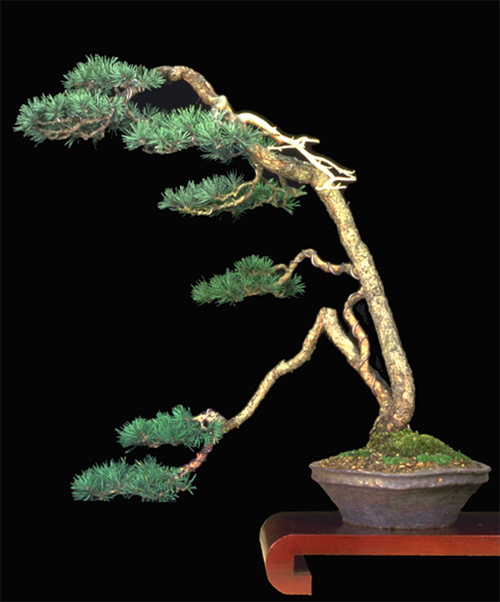
Faces of a transplanted bonsai artist. From Colin’s’ website.
From bad weather to more bad weather
Colin Lewis is a Englishman who somehow has ended up in the woods of Maine, where he raises bonsai, teaches, unpacks from his bonsai road show and drinks copious amounts of coffee in his pajamas. Most people who know Colin say that if you can get past his heavy foreign accent (joke!), you can learn a lot from him. Especially when it comes to the art of bonsai.
An uncommon mix
Among other things, Colin has a somewhat uncommon mix of talents. He can bonsai, he can teach, and, to top it off, he can write. So well in fact, that I once received an article for Bonsai Today (issue 79, on larch care) from him that didn’t need one single word (or even punctuation mark) changed. If you’ve ever been a publisher or especially an editor, you know just how rare this is.
But I digress, so without further ado, here’s Colin answering a few questions I emailed to him a while back.
Do you have, or have you had, bonsai teachers? (any stories?)
I never had a regular teacher, but I learned from so many fine artists. I lived close to Peter Adams and visited him from time to time. Dan Barton was another influence. I learned mostly by watching good people work – and still do.
What would you say are the most important things you’ve learned about bonsai?
They’re all important.
Do you consider bonsai an art?
Absolutely. But don’t look for comparisons with other artistic disciplines – there aren’t any.

Shimpaku from Colin’s website and from his book, Bonsai Design (unfortunately, out of print). The pot is by Dave Loweman.
Do you still get excited by bonsai?
Oh yes, but it’s different than in the old days when it was just me and the trees. I do get very excited by individual trees – pieces that I’ve been waiting until they, and I, are ready.
How about the daily routines? Are there bonsai tasks you’d rather not do?
Weeding.
Is teaching and selling bonsai and bonsai supplies your only source of income? Do you have any advice for others who are considering making a living from bonsai?
Yes it is, and yes I have: Don’t give up your day job!
Do you enjoy teaching? Do you prefer teaching newer or more advanced students?
Good question. Yes I enjoy teaching a lot, but sometimes it’s frustrating when there is a large varied group and little time. I prefer small groups and all day sessions. Beginners are great to teach because their excitement and enthusiasm is refreshing, and they can learn good habits right off the bat. Advanced students are rewarding to teach because they understand the more esoteric aspects of bonsai.
It’s the in-betweeners that are the hardest; people who have been going to demonstrations, workshops and club meetings for a decade or so and have so much conflicting information and believe all of it!.
What’s your approach when you teach? Do you mix it up, or do you tend to stick to the same format?
A teacher has to respond to the students at hand.

Colin’s famous JAL prize winning Scot’s pine. For more of Colin’s trees, you can visit the gallery section of his webiste.
What bonsai artists do you admire?
I admire peter Adams because he recognized bonsai as an art when it was still almost unheard of in England. There were no books until he wrote one, and no teachers until he became one. He turns out a mean bonsai too!
There are many of others, particularly in Europe. If I started to name names I’ll be here all night. I think I admire most the way the Europeans, the Italians and Spanish in particular, thrust themselves totally into the art. It’s that degree of enthusiasm that makes them so good, even at an amateur level. .
Is there anything going on in the bonsai universe right now that you are excited about? Anything that bothers you?
These days the bonsai usiverse is two acres of rocky woods in southern Maine with just enough flat land to grow a few trees. This is the first time oin a decade that I’ve been able to walk out in my pajamas in the morning and drink my coffee while checking my trees, and that’s exciting.
The influence that the internet has developed is exciting, too. There is so much more out there now. You can see wonderful work by people from all over the world and communicate with them freely. It’s much better than it was a decade ago when all you had were the forums and endless questions about dying serissas.
I’ve just been to the second national exhibition and the standard was somewhat higher than the first. Things are beginning to move, but it’s such a slow process that excitement is not the word.
Anything that bothers you?
As I said, progress is slow.
Do you consider any species your favorite?
Nah! I have likes and dislikes, and a few pet hates. I like most deciduous species. I like larch, most pines, old shimpaku juniper. I dislike most ficus although I really like nerifolia if grown well. I dislike black pines, because they’re too much work. I dislike kingsville boxwood and that minutely ramified chinese elm that is so dreadful that I can’t even remember its name – both for the same reason. And I’d be quite happy if I never saw another san jose or procumbens juniper again!
Do you think there is a distinctive American style bonsai. How about regional styles?
No, there isn’t a distinctive American style, it’s too diverse a geography for that. Regional styles, yes, but that is largely influenced by species.
Do you have plans to write any more books?
As I said, progress is slow.
How’s your new location going?
Everything’s up and running – studio, nursery, apartment, etc – if a little chaotic at the moment. I’m halfway through renovating the house and the studio, but we work around it. It’s a great place to live and work.
Do you drink when you work on your trees?
Yes, copious amounts of strong coffee until mid-afternoon, and copious amounts of strong tea from thereon. Some form of mental lubrication is okay if you’re thinking of designing a new tree, or you’re dreaming up some creative masterpiece, or analysing an established tree – but step away from the tools!
Any other questions you’d like to answer?
Ye gods man! Isn’t that enough!?: